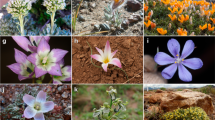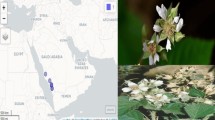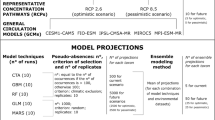Abstract
The identification of species-rich areas and their prognosticated turnover under climate change are crucial for the conservation of endemic taxa. This study aims to identify areas of reptile endemicity richness in a global biodiversity hot spot (Morocco) under current and future climatic conditions and to investigate the role of protected areas in biodiversity conservation under climate change. Species distribution models (SDM) were performed over the distribution of 21 endemic reptiles, combined to estimate current species richness at 1 × 1 km resolution and projected to years 2050 and 2080 according to distinct story lines and ensemble global circulation models, assuming unlimited and null dispersion ability. Generalized additive models were performed between species richness and geographic characteristics of 43 protected areas. SDM found precipitation as the most important factor related to current species distributions. Important reductions in future suitable areas were predicted for 50 % of species, and four species were identified as highly vulnerable to extinction. Drastic reductions in species-rich areas were predicted for the future, with considerable variability between years and dispersal scenarios. High turnover rates of species composition were predicted for eastern Morocco, whereas low values were forecasted for the Northern Atlantic coast and mountains. Species richness for current and future conditions was significantly related to the altitude and latitude of protected areas. Protected areas located in mountains and/or in the Northern Atlantic coast were identified as refugia, where population monitoring and conservation management is needed.




Similar content being viewed by others
References
Allouche O, Tsoar A, Kadmon R (2006) Assessing the accuracy of species distribution models: prevalence, kappa and the true skill statistic (TSS). J Appl Ecol 43:1223–1232
Araújo MB, Thuiller W, Pearson RG (2006) Climate warming and the decline of amphibians and reptiles in Europe. J Biogeogr 33:1712–1728
Barata M, Perera A, Martínez-Freiría F, Harris DJ (2012a) Cryptic diversity within the Moroccan endemic day geckos Quedenfeldtia (Squamata: Gekkonidae): a multidisciplinary approach using genetic, morphological and ecological data. Biol J Linn Soc 106:828–850
Barata M, Carranza S, Harris DJ (2012b) Extreme genetic diversity in the lizard Atlantolacerta andreanskyi (Werner, 1929): a montane cryptic species complex. BMC Evol Biol 12:167
Barbet-Massin M, Jiguet F, Albert CH, Thuiller W (2012) Selecting pseudo–absences for species distribution models: how, where and how many? Methods Ecol Evol 3:327–338
Bons J, Geniez P (1996) Amphibiens et reptiles du Maroc (Sahara Occidental compris). Atlas biogéographique. Asociación Herpetológica Española, Barcelona
Brito JC (2003) Observations of amphibians and reptiles from North and West Africa—Morocco, Mauritania and Senegal. Bol Asoc Herpetol Esp 14:2–6
Brito JC, Fahd S, Martínez-Freiría F, Tarroso P (2011) Climate change and peripheral populations: predictions for a relict Mediterranean viper. Acta Herpetol 6:105–118
Brook BW, Sodhi NS, Bradshaw CJA (2008) Synergies among extinction drivers under global change. Trends Ecol Evol 23:453–460
Brooker RW, Travis JMJ, Clark EJ, Dytham C (2007) Modelling species’ range shifts in a changing climate: the impacts of biotic interactions, dispersal distance and the rate of climate change. J Theor Biol 245:59–65
Buisson L, Thuiller W, Casajus N, Lek S, Grenouillet G (2010) Uncertainty in ensemble forecasting of species distribution. Glob Chang Biol 16:1145–1157
Butchart SHM, Walpole M, Collen B, van Strien A, Scharlemann JPW, Almond RE, Baillie JEM, Bomhard B, Brown C, Bruno J, Carpenter KE, Carr GM, Chanson J, Chenery AM, Csirke J, Davidson NC, Dentener F, Foster M, Galli A, Galloway JN, Genovesi P, Gregory RD, Hockings M, Kapos V, Lamarque J-F, Leverington F, Loh J, McGeoch M, McRae L, Minasyan A, Hernández Morcillo M, Oldfield TEE, Pauly D, Quader S, Revenga C, Sauer JR, Skolnik B, Spear D, Stanwell-Smith D, Stuart SN, Symes A, Tierney M, Tyrrell TD, Vié J-C, Watson R (2010) Global biodiversity: indicators of recent declines. Science 328:1164–1168
Carranza S, Arnold EN, Geniez P, Roca J, Mateo JA (2008) Radiation, multiple dispersal and parallelism in the skinks, Chalcides and Sphenops (Squamata: Scincidae), with comments on Scincus and Scincopus and the age of the Sahara Desert. Mol Phylogenet Evol 46:1071–1094
Carvalho SB, Brito JC, Crespo EJ, Possingham HP (2010) From climate change predictions to actions—conserving vulnerable animal groups in hotspots at a regional scale. Glob Chang Biol 16:3257–3270
Carvalho SB, Brito JC, Crespo EJ, Possingham HP (2011) Incorporating evolutionary processes into conservation planning using species distribution data: a case study with the western Mediterranean herpetofauna. Divers Distrib 17:408–421
Charco J (1999) El Bosque Mediterráneo en el Norte de África: biodiversidad y lucha contra la desertificación. Agencia Española de Cooperación Internacional, Madrid
Collins M, Chandler RE, Cox PM, Huthnance JM, Rougier J, Stephenson DB (2012) Quantifying future climate change. Nat Clim Chang 2:403–409
Cox N, Chanson J, Stuart S (2006) The status and distribution of reptiles and amphibians of the Mediterranean Basin. IUCN Gland, Switzerland
Crochet P-A, Sweet SS, Mateo JA (2004) Recent records of the rare Psammodromus microdactylus (Boettger, 1881) in Morocco. Herpetozoa 17:184–186
Cuttelod A, García N, Abdul Malak D, Temple H, Katariya V (2008) The Mediterranean: a biodiversity hotspot under threat. In: Vié JC, Hilton-Taylor C, Stuart SN (eds) The 2008 review of the IUCN Red List of Threatened Species. IUCN Gland, Switzerland, pp 89–101
Dawson TP, Jackson ST, House JI, Prentice IC, Mace GM (2011) Beyond predictions: biodiversity conservation in a changing climate. Science 332:53–58
de Pous P, Beukema W, Weterings M, Dümmer I, Geniez P (2011) Area prioritization and performance evaluation of the conservation area network for the Moroccan herpetofauna: a preliminary assessment. Biodivers Conserv 20:89–118
Diniz-Filho JAF, Bini LM, Fernando Rangel T, Loyola RD, Hof C, Nogués-Bravo D, Araújo MB (2009) Partitioning and mapping uncertainties in ensembles of forecasts of species turnover under climate change. Ecography 32:897–906
Elith J, Graham CH, Anderson RP, Dudyk M, Freer S, Guisan A, Hijmans RJ, Huettmann F, Leathwick JR, Lehmann A, Li J, Lohmann LG, Loiselle BA, Manion G, Moritz C, Nakamura M, Nakazawa Y, McOverton J, Peterson AT, Phillips S, Wisz MS, Zimmermann NE (2006) Novel methods improve prediction of species’ distributions from occurrence data. Ecography 29:129–151
Fordham DA, Wigley TM, Brook BW (2011) Multi-model climate projections for biodiversity risk assessments. Ecol Appl 21:3317–3331
Fordham DA, Wigley TM, Watts MJ, Brook BW (2012) Strengthening forecasts of climate change impacts with multi–model ensemble averaged projections using MAGICC/SCENGEN 5.3. Ecography 35:4–8
Garcia RA, Burgess ND, Cabeza M, Rahbek C, Araújo MB (2012) Exploring consensus in 21st century projections of climatically suitable areas for African vertebrates. Glob Chang Biol 18:1253–1269
Garzón MB, Alía R, Robson TM, Zavala MA (2011) Intra-specific variability and plasticity influence potential tree species distributions under climate change. Glob Ecol Biogeogr 20:766–778
Geniez P, Mateo JA, Geniez M, Pether J (2004) The amphibians and reptiles of the Western Sahara (former Spanish Sahara) and adjacent regions. Edition Chimaira, Frankfurt
Gillingham PK, Huntley B, Kunin WE, Thomas CD (2012) The effect of spatial resolution on projected responses to climate warming. Divers Distrib 18:990–1000
Giovanelli JGR, Ferreira de Siqueira M, Haddad CFB, Alexandrino J (2010) Modeling a spatially restricted distribution in the Neotropics: how the size of calibration area affects the performance of five presence-only methods. Ecol Model 221:215–224
Harris DJ, Carretero MA, Brito JC, Kaliontzopoulou A, Pinho C, Perera A, Vasconcelos R, Barata M, Barbosa D, Carvalho S, Fonseca MM, Pérez-Lanuza G, Rato C (2008) Data on the distribution of the terrestrial herpetofauna of Morocco: records from 2001–2006. Herpetol Bull 103:19–28
Harris DJ, Perera A, Barata M, Tarroso P, Salvi D (2010) New distribution notes for terrestrial herpetofauna from Morocco. Northwest J Zool 6:309–315
Hastie TJ, Tibshirani RJ (1990) Generalized additive models. CRC monographs on statistics & applied probability. Chapman & Hall, London
Hernandez PA, Graham CH, Master LL, Albert DL (2006) The effect of sample size and species characteristics on performance of different species distribution modeling methods. Ecography 29:773–785
Hijmans RJ, Cameron SE, Parra JL, Jones PG, Jarvis A (2005) Very high resolution interpolated climate surfaces for global land areas. Int J Climatol 25:1965–1978
Hoffmann AA, Sgrò CM (2011) Climate change and evolutionary adaptation. Nature 470:479–485
in den Bosch HAJ (2005) Psammodromus microdactylus (Boettger, 1881), a rare lizard species? Pod@rcis 6:2–35
IPCC-TGICA (2007) General guidelines on the use of scenario data for climate impact and adaptation assessment, version 2. Prepared by T. R. Carter on behalf of the Intergovernmental Panel on Climate Change, Task Group on Data and Scenario Support for Impact and Climate Assessment
Kissling WD, Dormann CF, Groeneveld J, Hickler T, Kühn I, McInerny GJ, Montoya JM, Römermann C, Schiffers K, Schurr FM, Singer A, Svenning J-C, Zimmermann NE, O’Hara RB (2012) Towards novel approaches to modelling biotic interactions in multispecies assemblages at large spatial extents. J Biogeogr 39:2163–2178
Lemes P, Loyola RD (2013) Accommodating species climate-forced dispersal and uncertainties in spatial conservation planning. PloS one 8:e54323
Liu C, Berry PM, Dawson TP, Pearson RG (2005) Selecting thresholds of occurrence in the prediction of species distributions. Ecography 28:385–393
Machado AL, López-Jurado F, Martín A (1985) Conservation status of reptiles in the Canary Islands. Bonn Zool Beitr 36:585–606
Malcolm JR, Liu C, Neilson RP, Hansen L, Hannah L (2006) Global warming and extinctions of endemic species from biodiversity hotspots. Conserv Biol 20:538–548
Marmion M, Parviainen M, Luoto M, Heikkinen RK, Thuiller W (2009) Evaluation of consensus methods in predictive species distribution modeling. Divers Distrib 15:59–69
Mittermeier RA, Robles Gil P, Hoffmann M, Pilgrim J, Brooks T, Mittermeier CG, Lamoreux J, da Fonseca GAB (2004) Hotspots revisited: earth’s biologically richest and most endangered terrestrial ecoregions. Cemex, Monterrey, and University of Chicago Press, Chicago
Moreno-Rueda G, Pleguezuelos JM, Pizarro M, Montori A (2012) Northward shifts of the distributions of Spanish reptiles in association with climate change. Conserv Biol 26:278–283
Parmesan C (2006) Ecological and evolutionary responses to recent climate change. Annu Rev Ecol Evol Syst 37:637–669
Perera A, Harris DJ (2010) Genetic variability in the ocellated lizard Timon tangitanus in Morocco. Afr Zool 45:321–329
Phillips SJ, Anderson RP, Schapire RE (2006) Maximum entropy modeling of species geographic distributions. Ecol Model 190:231–259
Pleguezuelos JM, Brito JC, Fahd S, Feriche M, Mateo JA, Moreno-Rueda G, Reques R, Santos X (2010) Setting conservation priorities for the Moroccan herpetofauna: the utility of regional red lists. Oryx 44:501–508
Pough FH (1980) The advantages of ectothermy for tetrapods. Am Nat 115:92–112
Sinervo B, Méndez-de-la-Cruz F, Miles DB, Heulin B, Bastiaans E, Villagrán-Santa Cruz M, Lara-Resendiz R, Martínez-Méndez N, Calderón-Espinosa ML, Meza-Lázaro RN, Gadsden H, Avila LJ, Morando M, De la Riva IJ, Victoriano Sepulveda P, Rocha CFD, Ibargüengoytía N, Aguilar Puntriano C, Massot M, Lepetz V, Oksanen TA, Chapple DG, Bauer AM, Branch WR, Clobert J, Sites JW (2010) Erosion of lizard diversity by climate change and altered thermal niches. Science 328:894–899
Thomas CD, Cameron A, Green RE, Bakkenes M, Beaumont LJ, Collingham YC, Erasmus BFN, Ferreira de Siqueira M, Grainger A, Hannah L, Hughes L, Huntley B, van Jaarsveld AS, Midgley GF, Miles L, Ortega-Huerta MA, Peterson AT, Phillips OL, Williams SE (2004) Extinction risk from climate change. Nature 427:145–148
Thuiller W (2004) Patterns and uncertainties of species’ range shifts under climate change. Glob Chang Biol 10:2020–2027
Thuiller W, Lafourcade B, Engler R, Araújo MB (2009) BIOMOD—a platform for ensemble forecasting of species distributions. Ecography 32:369–373
Thuiller W, Georges D, Engler R (2012) Package “biomod 2” version 2.1.15. Available at http://cran.r-project.org/web/packages/biomod2/biomod2.pdf
VanDerWal J, Shoo LP, Graham C, Williams SE (2009) Selecting pseudo-absence data for presence-only distribution modeling: how far should you stray from what you know? Ecol Model 220:589–594
Velo-antón G, Godinho R, Harris DJ, Santos X, Martínez-Freiría F, Fahd S, Larbes S, Pleguezuelos JM, Brito JC (2012) Deep evolutionary lineages in a Western Mediterranean snake (Vipera latastei/monticola group) and high genetic structuring in Southern Iberian populations. Mol Phylogenet Evol 65:965–973
Westerström A (2010) Early record of the elusive Atlas Dwarf Viper Vipera monticola SAINT GIRONS, 1953, in the Moroccan High Atlas. Herpetozoa 23:103–104
Wiens JA, Stralberga D, Jongsomjita D, Howella CA, Snyder MA (2009) Niches, models, and climate change: assessing the assumptions and uncertainties. PNAS 106:19729–19736. http://www.pnas.org/content/106/suppl.2/19729.full
Acknowledgments
This study was partially supported by project POCTI/BIA-BDE/55596/2004 from Fundação para a Ciência e Tecnologia (FCT, Lisbon, Portugal), by Cooperation CNRST-FCT (2008–2009), and by project “Biodiversity, Ecology and Global Change” cofinanced by North Portugal Regional Operational Programme 2007/2013 (ON.2—O Novo Norte), under the National Strategic Reference Framework (NSRF), through the European Regional Development Fund (ERDF). FMF is supported by FCT (SFRH/BPD/69857/2010). The authors acknowledge M. Barata, D.J. Harris, D. Salvi, S. Ferreira, C. Vale, Z. Boratyński, G. Velo-Antón, P. Sierra, and A. Pérez for helping with the fieldwork carried out during 2012 and the four anonymous referees for their comments in the early version of this work.
Author information
Authors and Affiliations
Corresponding author
Additional information
Communicated by: Sven Thatje
Electronic supplementary material
Below is the link to the electronic supplementary material.
ESM 1
(PDF 885 kb)
Rights and permissions
About this article
Cite this article
Martínez-Freiría, F., Argaz, H., Fahd, S. et al. Climate change is predicted to negatively influence Moroccan endemic reptile richness. Implications for conservation in protected areas. Naturwissenschaften 100, 877–889 (2013). https://doi.org/10.1007/s00114-013-1088-4
Received:
Revised:
Accepted:
Published:
Issue Date:
DOI: https://doi.org/10.1007/s00114-013-1088-4




